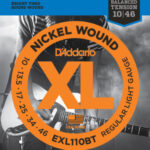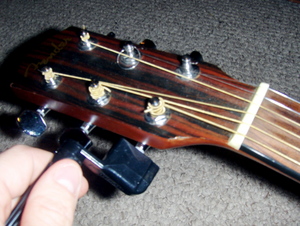Many people think restringing a guitar is impossible and should only be left for the guitar shop to handle. I’m here to tell you that you and they are wrong. It’s extremely easy to do, even with little guitar knowledge. All you need is some guitar strings. That’s it. Of course I highly recommend you get some tools first.
When do I need to restring?
How are you supposed to know when to restring your guitar? Well, there are three sure methods of knowing. First, one of your strings have snapped off and probably caused you a heart attack from the startling experience. Second, you can tell by running a fingernail underneath the string. If there is black junk under it, it’s probably restringing time again or every couple of months. Last method of knowing is if your guitar gets run over by a truck. However, that is a different story for a different time. The more common occurrences are the first two methods.
Tools
You don’t technically need any of these other than the strings, but it makes it turn from a five hour job into about a half hour to an hour. The most important tool is a tuner. The tuner will help you get it into tune after you restring it so you know when to stop winding. Next, you will need a guitar string winder. It will make it 23 times faster unwinding the peg this way. Yes, I made that up, but it makes it a lot faster, so buy one and stop questioning my facts. A handy feature is to buy a guitar string winder with a string cutter on the other end. An all-in-one deal, but if you’re cheap like me, I had a wire cutter at my house which worked fine for restringing the guitar.
What strings do I need to buy?
I’ll be honest. There are an incredible amount of strings that are behind the counter at those guitar shops and the like. How could you possibly know what to buy? First of all, ask the person behind the counter. They should know about strings and should be able to guide you in the right direction. Tell them what genre of music you play and they will probably be able to help more. But the general rule is, if you want something that would play well for blues, get a lighter gauge. If you are into the more heavy, metal-type genres, go for the heavier gauges. Also, heavier gauges generally last longer because they aren’t tiny like the lighter gauges and aren’t as prone to snapping. It all boils down to personal choice, though. Just buy anything that goes with a guitar and it should be a learning experience. You will either like it a lot, or dislike it or be indifferent. Use that experience to experiment and to try different brands and gauges.
How do I restring the guitar?
Ok, the hard part. This is the part where you’ll get that sinking stomach feeling if you messed up the strings. But it’s ok. The strings are only about 5 dollars. Maybe you should buy two packs for your first time just to be safe. Anyway, let’s move on to the restringing of your guitar. First, if none of your strings have snapped, I suggest you start with the thinnest E string. It’s the easiest to deal with. If you have snapped a different string, start with that one and then go to the thinnest E string. Just remember which one you actually started with. Now unwind the tuning peg and make sure it’s getting looser and not tighter. You don’t want to get slapped by a wire. Once you can pull the string up a couple inches without using any pressure, snip the string in the middle with wire cutters. Now take one end out of the hole and the other out of the tuning peg. You don’t necessarily need wire cutters, but it saves your guitar from getting scratched by the bent wires. Plus, it’s just faster.
Now, before you open up the first, thinnest E string, take a pencil with graphite, mechanical or standard, and just start rubbing the graphite into the little slot. It’s ok if it doesn’t fit into the slot; you just want the graphite dust in there. After you have rubbed it a little, open your lowest decimal string package. What I mean by that is the little envelop should have a number written on it. Go for the lowest possible one. If it doesn’t, feel each envelop and they should be in order, so just find the thinnest one.
Now, it will be coiled in the package, so be careful. Don’t want to make a kink in the main part of the string. Ok, you’ll have to un-loop the string a couple times. After that it should slink apart and be a straight string. After you got it straight, insert it into the empty hole where you just took the other string out from. Now pull it through until the little butt end of the string is resting on the edge of the hole. Basically, just pull it until it won’t pull any more. Line it up with the slot at the bridge and then the nut at the top.
This part will be a little bit tricky. If you have 3 by 3 tuning pegs at the top (like a Les Paul), you’ll want to make sure the string has no slack in it and measure the extra string that goes over the tuning peg you are going to insert it in. You want to make a small little bend away from the head of the guitar at the tuning peg right above the one you are going to insert it in. So if you are restringing the thinnest E string, you’ll want to make a bend in the extra string at the tuning peg for the B string. If you are restringing a G or D string which doesn’t have a tuning peg above them, use your fingers and estimate how long it is and make a bend. If you have a guitar with tuning pegs like a Stratocaster, then use two peg lengths apart rather than one.
Unfortunately, this part is even harder than the last. Take the bent string and poke it through the little hole in the tuning peg. You will want to make sure the string that you just poked through (the edge of it) is above the rest of the string. Now hold the string down and start winding it tighter with your string winder. Make sure the string stays in the slots while you are winding it up.
You should have a wound string and it should at least look decent. It’s ok if it looks bad, it’s your first try, or close to your first try. It doesn’t even matter too much if it is a bad restringing job. Next part is important if you want the strings to stay in tune however. Once your string is tuned to the desired pitch, pull the string up about 2 inches to stretch the string a little bit. It should go out of tune now. Just retune and re-stretch. Keep stretching and tuning until it stops going out of tune whenever you stretch it. Now move on and finish restringing your guitar. Congratulations, you just restrung your guitar!



